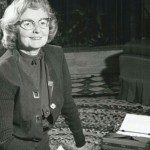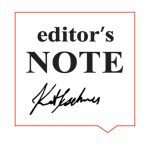The Long Game
Steve Paikin isn’t afraid to be boring if it means smart television. Now, his show, The Agenda, hopes its punchier digital strategy is a winner
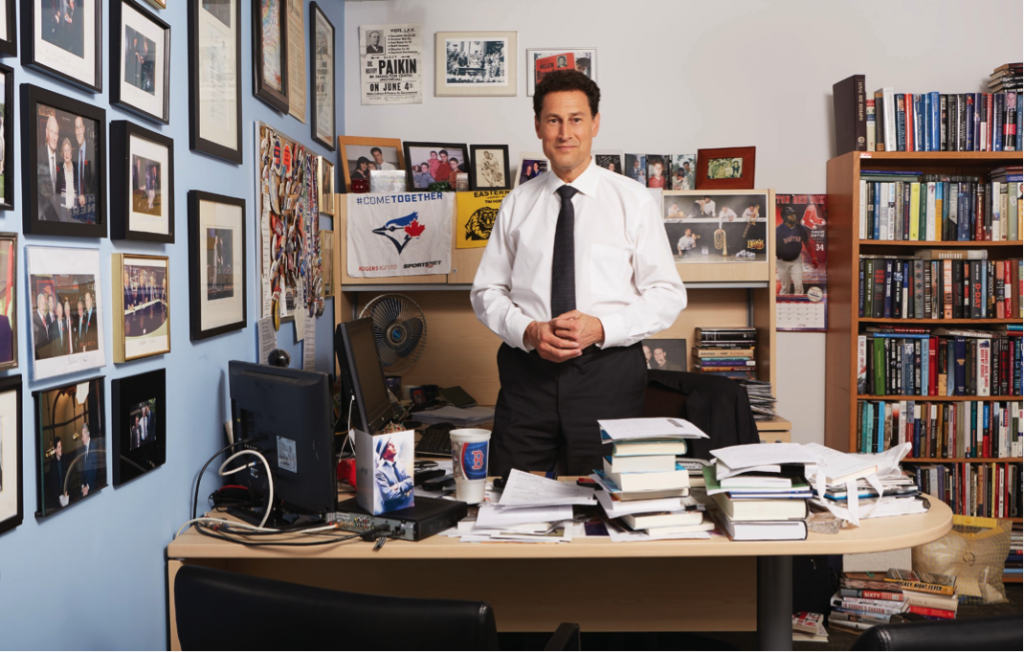
A love of sports first brought Steve Paikin into journalism. In his office as host of TVO’s The Agenda, he still displays that passion. Photo by Laura Arise
Steve Paikin strides out of his fourth-floor office just before 9 a.m. His billowing T-shirt and messy hair make him look different from the trim man in a suit familiar to TVOntario viewers. He cradles a stack of books and a newspaper under his arm. The host of The Agenda walks through the giant, red doors on the first floor of TVO’s midtown Toronto building. He hurries through a dark hallway and into a little room to wait for the makeup artist. Flicking on the fluorescent lights, he drops into a leather chair and unfurls The New York Times—the last of the four newspapers he reads each day. After makeup, he’ll head upstairs to write a blog post. Then, down to the set to shoot a two-on-one interview. Later, he’ll grab lunch with some sources, return to the set for three one-on-ones, attend an event hosted by the lieutenant governor and—finally—celebrate his son’s 22nd birthday at a hockey game. At home, he’ll read over questions, scripts and books for tomorrow’s tapings.
For Paikin, it’s just an ordinary day, except that opposite the makeup room is The Agenda’s brand new set. No more dark blue walls, dim lighting and harsh fonts. Instead, a giant screen lights up behind a glass desk and a red, lower case “a.”—the new logo. The set’s not the only change. The show’s 10th anniversary also means a new website and a focus on digital audiences, including the production of shorter segments that are easier to share online. But the producers of The Agenda—a show known for lengthy interviews and discussions—say they haven’t caved to broadcast trends used to woo younger audiences with more flash and less substance. Instead, they intend to do what the show has always done, just more effectively. A large part of that continuity is The Agenda’s host, Steve Paikin.
Everyone says he’s the same person onscreen and off a well-informed, enthusiastic political nerd who can’t stop watching (and tweeting) what’s going on around him. His colleagues wonder when he sleeps. Paikin and his show are earnest; executive producer Stacey Dunseath says, “He’s just a guy.” That’s what makes him a great interviewer. Without the drive for advertising dollars, the public television show has been a good outlet for Paikin’s slow, deeply inquisitive journalism. As he says, “We really are sort of daring to bore you.”
“9:17! Great!” Paikin jumps out of the chair and thanks the make-up artist. In the elevator, he scrolls through blog post ideas he has saved in his BlackBerry. He has just 45 minutes to write one before his first taping. In his office, he drops into a chair behind a desk cluttered with books and stacks of paper. The walls are just as crowded: two framed newspaper clippings lean against the wall, including a full-page National Post article Paikin wrote about a man’s return to Auschwitz 70 years after being freed from the concentration camp. “I am a victor. I have survived,” reads the headline. Paikin helped the man, Mordechai Ronen, tell the story of his life and liberation in a 2015 book, I Am A Victor.
The office is also a shrine to Paikin’s sports obsession. A Boston Red Sox letterman jacket and a Toronto Maple Leafs scarf are draped on the back of a chair. A giant picture of Ted Williams swinging a bat hangs above a grid of smaller photos of a young Paikin at various Super Bowl games.
Colourful campaign buttons and photos of Paikin posing with politicians cover another wall. Behind the desk, even more photos: him with his wife, daughter and sons. A wooden bookshelf is overstuffed with works by authors he’s interviewed. There’s no coffee mug anywhere—he never drinks coffee—just a bag of rice cakes and a jar of peanut butter for when things get busy.
Paikin types as news plays on his computer and a TV across from him runs hockey highlights. The consistent ding of emails arriving in his inbox adds to the noise. Suddenly, Paikin stops typing. “Oh! Premier photo op!” he says. He expands a video of Kathleen Wynne announcing the start of beer sales in Ontario grocery stores. Paikin whips out his phone, takes a picture of the screen and sends a tweet.
He splits his computer screen: one half streams Wynne’s announcement, the other holds his Word file. He turns down the volume on the hockey highlights and gets back to writing.
Growing up in Hamilton, Ontario, Paikin gave little indication he would end up the host of a serious current affairs show. In the fall of 1977, the 18-year-old first year walked into Hart House, the University of Toronto’s Gothic-revival student centre. Student clubs had booths inside the building, and Paikin spotted a table for the campus radio station. “And, literally, a light went on. Not literally, I guess. Figuratively, a light went on.”
He asked if anyone was doing play-by-play for Varsity Blues hockey and football games. When he found out there was an opening, he thought, “So I could be the Foster Hewitt of the U of T?” He wasn’t interested in much outside of sports. “I don’t think I read the front section of the newspaper until I was 19 years old.”
After becoming sports editor at The Newspaper, an independent campus publication, he landed a summer job at The Hamilton Spectator. But there was a catch. “When I got to the Spec, they said, ‘Okay, we’ll give you a summer job, but you can’t cover sports.’” Instead, he covered city council and school boards, and chased ambulances. “I really got turned onto news that summer, and I still loved sports but didn’t feel an obligation to make that my professional life. And ever since, it’s been news and current affairs.”
He did a master’s degree in broadcast journalism at Boston University (mostly so he could go to Red Sox games at Fenway Park); covered Toronto City Hall for CHFI, the sister radio station of what is now known as 680 News; and then applied for an opening at CBC. “I was really unsure, because he had never done TV,” says Howard Bernstein, the producer who gave him the job. “I sent him out to do a fake report with a crew and, to be honest, the report wasn’t great. But his personality was. I could tell that, with a bit of TV training, he could be good.”
A few years later, after a stint as news director for Global, Bernstein left for TVO and hired Paikin for a political series called Between the Lines. That led to a 12-year job as co-host of Studio 2, a daily current affairs show featuring interviews, debate panels and documentaries. But by 2006, it was getting dated and too expensive to produce, at least by public broadcasting standards. TVO executives asked producer Dan Dunsky to come up with something new.
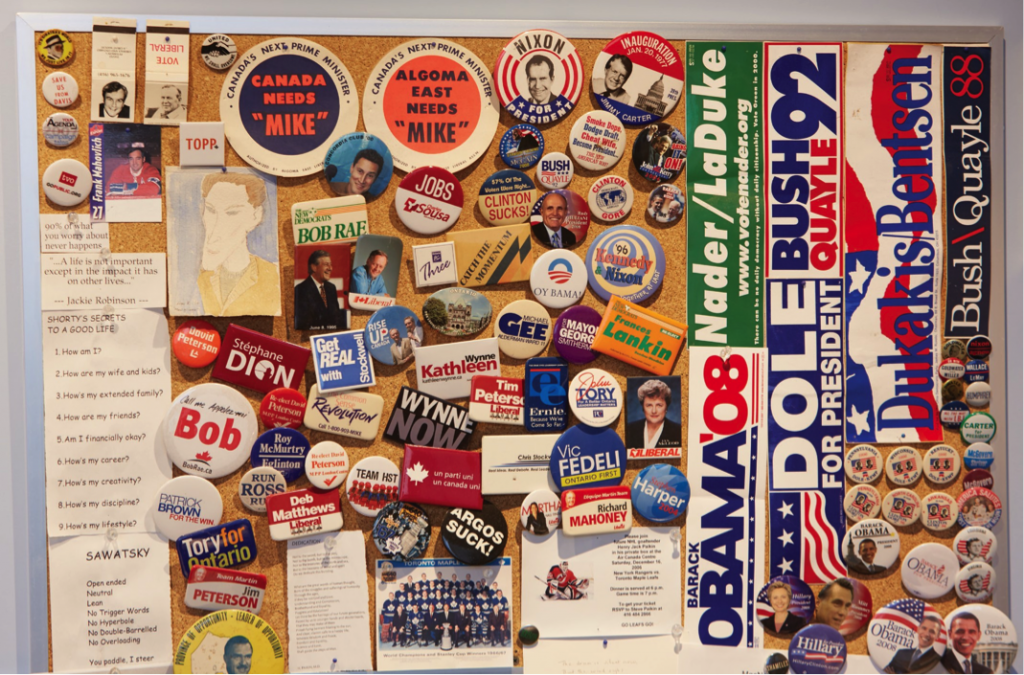
Paikin’s obsessive interest in politics makes him an ideal moderator and an excellent interviewer of big-name politicians. Photo by Laura Arise
“Take two!” Paikin says as three producers march into his office with a pile of papers. They’re here to do a second read-through of a segment to be taped later today. “Healthy eating, regular exercise, positive thinking.” His voice booms through the office. “They’re all keys to a better life, right? Wrong, according to our next guest…”
The producers nod and file out. But before Paikin can get back to proofreading his blog post, Dunseath marches in.
“Are you putting on the blue suit?” she asks. A new set means new colours and new clothes.
Paikin and Dunseath walk to the elevator, talking suits, segments and cancelled meetings. The next segment, about unpaid farm interns, is one of the first they’ll shoot on the new set. The issue is under-covered, but interesting. A perfect fit for The Agenda—and Paikin’s talents. “There’s nobody in the country who can do what Steve does,” says Dunsky, who wanted to showcase those talents when creating TVO’s new current affairs program. “To be able to assimilate enormous amounts of information on complex topics and then manage a polite, serious, civil, engaging conversation was really an idea that was ideally suited to his skills.”
The Agenda was born at just the right time. Just five years after 9/11 and three years into the Iraq War, “ammunition journalism,” as Dunsky calls it, dominated. “Every issue was being amped up into black-and-white, yes-or-no, it’s-this-or-it’s-that-way coverage,” he explains. “And what was being lost was any kind of nuance, context, sense of complexity of issues.” Paikin and Dunsky didn’t want people to walk away from their show with more ammunition to defend an argument they already believed. Instead, they wanted viewers to step away with more questions or an understanding that issues may be more complicated than they thought. TVO was the right place to give discussions the time they deserved.
Downstairs, the studio is buzzing. Producers pass around scripts and greet guests. On the set, the camera zooms in and out on a white shirt, green tie and navy jacket on the host chair. The crew is trying out new colours with the new background.
The set is bright. The dark blue background has been replaced by a huge, white, rectangular screen that shows simple graphics for context or creates ambience for an interview. A V-shaped desk that seats seven people rests on a red platform in the centre of the set. A smaller desk, for one-on-one interviews, is on a platform off to the side. The platforms have wheels that allow them to be moved in and out when needed.
Two bookcases have been moulded into the wall, with the books arranged more strategically than in Paikin’s office. Around the set, and on the bookshelf, are framed photos of politicians and Ontario scenes. In the centre of one shelf is a black-and-white portrait of Donald Pounder, a loyal fan who bequeathed a fortune to TVO. He marked a sum just for The Agenda—a reminder of how attached some viewers remain to public broadcasting.
The books, the photos—they’re all meant to represent Paikin’s interests and heroes. Early in the redesign, he said the only thing that mattered was the distance between him and his guests—he wanted them close by. Some people have never been on television and are often nervous on camera. Paikin knows that the best guests are relaxed, and the best interviews seem like casual conversations.
Discussions about the redesign began in mid-2015, but a larger digital movement was already underway at TVO. The network started by separating current affairs from TVO Kids and hiring John Ferri, former digital editor at the Toronto Star. His first task was to relaunch TVO’s website. Instead of driving readers to watch the shows on television, the new website focuses on keeping them reading and watching online. Next, the new department set its sights on The Agenda.
Over the last five or so years, the program moved from going live at 8 p.m. to taping in advance. One producer handled each episode, either an hour-long interview or a few related segments. Now, producers are responsible for individual segments, which are not necessarily related to the others in an episode. In fact, some will be available only online. The goal is to create content that’s easier to watch and share. Even the set was designed to make sure the viewing experience works on phones, tablets and desktops as well as on televisions.
All this might seem like The Agenda is abandoning its loyal, typically older viewers. On average, about 630,000 Ontarians tune in to at least part of an episode. Most are over 55. But Ferri isn’t looking for the 18-to-34 BuzzFeed demographic, focusing instead on people in their thirties, forties and fifties. He also believes the original viewers will stick around because the quality of the journalism hasn’t changed.
Behind the scenes, the show proceeds as it always has. On occasion, producers ask Paikin to leave a little breathing room at the end of a segment or in between scripted breaks so they can cut shorter pieces for a teaser. Viewers might watch a teaser or shorter segment on Twitter or Facebook, then go to TVO’s website to watch the full segment—that’s the goal, anyway. Ferri hopes to give people what they want on the platform of their choice.
But the show remains committed to in-depth journalism and still spends a full hour on topics when it makes sense. The tone, approach and topics won’t change. “Yes, it’s a little updated, but it’s still Steve in the foreground, still Steve asking a series of in-depth questions to people who aren’t the usual suspects on TV,” Ferri says. “That’s tricky, but that’s our commitment to the journalism.”
“Your suit is nearly as stylish as your guests’ suits,” someone says as Paikin walks into the control room. The host seems relaxed, even jovial. After a quick read-through and a small change—“Can somebody fact check: is it Sir Wilfrid Laurier University or Wilfrid Laurier University?”—Paikin gathers his papers and sits down with his two guests.
“Okay, here we go,” the director says. “In seven…six, recording, four, three, two, one…”
“Many small Ontario farms rely heavily on volunteers and unpaid interns for their labour force. Joining us now to consider how that squares with food movements focused on justice and sustainability…” he starts the intro. Paikin is in his element. He’s happy to let the rest of the team run the show in the nitpicky aspects of the redesign and the imagery. For him, all that matters is the journalism.
Paikin lives for good interviews and is proud of his best ones. In November 2011, former U.S. President Bill Clinton was scheduled to deliver a keynote address on globalization at Toronto’s Massey Hall. Usually, the speech is followed by an on-stage interview, though the interviewer is rarely a journalist. Two days before the speech, the Ontario Chamber of Commerce called Paikin. It took him less than half a second to say yes.
Clinton’s office insisted on seeing the questions ahead of time; Paikin grudgingly agreed. He hoped to ask about Hillary Clinton’s files, the Republican presidential nomination race, the Keystone Pipeline. Clinton’s staff turned them all down. Eventually, they settled on eight questions that weren’t as edgy as Paikin wanted.
Backstage, he introduced himself to Clinton. “Can we talk about the interview for a moment?”
Clinton put his hands in his pockets and, in his Arkansas accent, said, “Ask me anything.”
Paikin abandoned the agreed-upon questions. He would do what he does best: take cues from his interview subject.
When the two finally settled on stage, he opened with a little history of some of the famous moments in Canadian politics that had happened on the same stage. He then turned to Clinton and said, “From north of the border, your political system looks utterly dysfunctional. Is it?”
The audience laughed.
After a pause, Clinton said, “Not completely.”
More laughter. Applause.
They went on to discuss many of the subjects the staff had told Paikin not to, including Newt Gingrich, the U.S. budget and the Occupy movement. Afterward, Paikin shook Clinton’s hand and later wrote, “That was one of the best bloody nights of my life.”
It’s not hard to see that he gets most excited when talking about politics—especially Ontario politics. He has written one book on hockey and one on the Holocaust, but five about politicians. In the introduction of his first book, 2001’s The Life: The Seductive Call of Politics, he wrote that he has a dirty secret, one he says no self-respecting journalist is ever supposed to admit. “I like politicians,” he wrote. “At least, the vast majority of the ones I’ve met.”
While stories about fumbles sell more newspapers, Paikin focuses on what makes political life alluring. And while he admits that a few are “corrupt, evil, vain, ignorant, incompetent and a whole bunch of other terrible things,” he finds many others are in it for the right reasons. He talks at length about Ontario’s 18th premier, Bill Davis, in many of his books and insisted on putting up a photo of Lincoln Alexander, the first Black MP, on set. “I like the fact that Lincoln’s here keeping an eye on me every time I do a program.”
Paikin’s knowledge of politicians and their motives comes through when he interacts with them on and off The Agenda. His interviews are less combative and more curious and conversational. He asked former Ontario Premier Dalton McGuinty about his relationship with his father before talking about the gas plant scandal.
It has also made him a popular choice as moderator for several federal and provincial leaders’ debates. In 2006, CBC’s senior reporter Keith Boag called to tell Paikin he’d be moderating his first federal debate. “I think I swore at him,” Paikin says. The networks had already considered several prominent names but couldn’t decide on a suitable choice. It couldn’t be someone with little knowledge of politics. It couldn’t be someone who was a big television personality. It couldn’t be someone who was strongly associated with CBC or CTV. And it couldn’t be anyone the parties vetoed.
Early on, Paikin and debate producer Mark Bulgutch agreed that the less the audience heard from the moderator, the better. Bulgutch, who praises Paikin’s ability to stay out of the way and still maintain control, says he’s not a typical TV personality. There are a few of those, especially at the local level: they come in an hour before the show and just read what’s in front of them. “This,” he says of Paikin, “is a journalist who’s on television.”
-
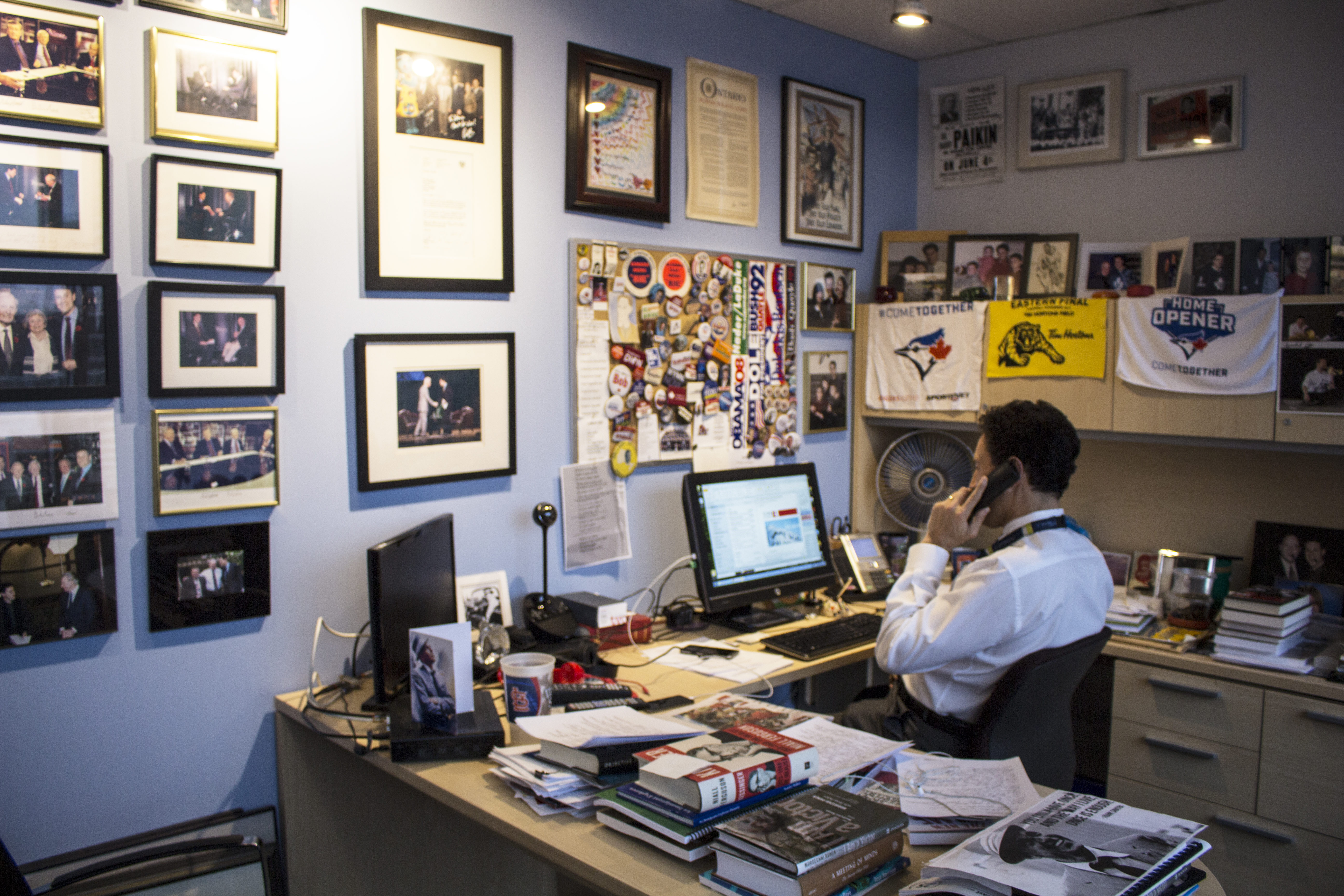

Paikin surrounds himself with items he’s picked up throughout his career. Some represent his interests; others are gifts from friends. Here are just a few
-
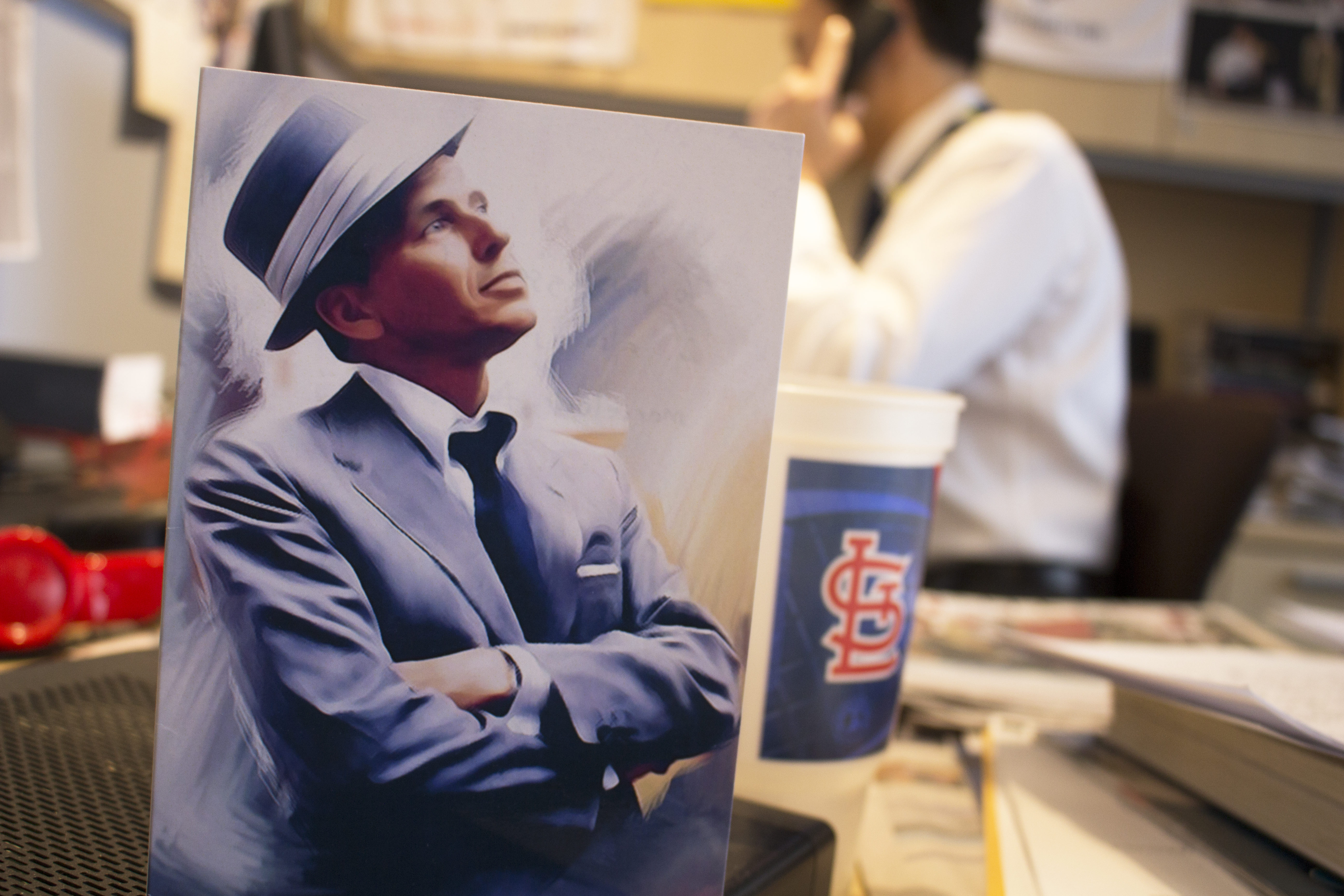

At the end of each of his books, Paikin likes to thank someone who’s had nothing to do with its writing. The last line of The Life: The Seductive Call of Politics reads “Oh, and one more thank you. To Frank Sinatra. Just…because”
-
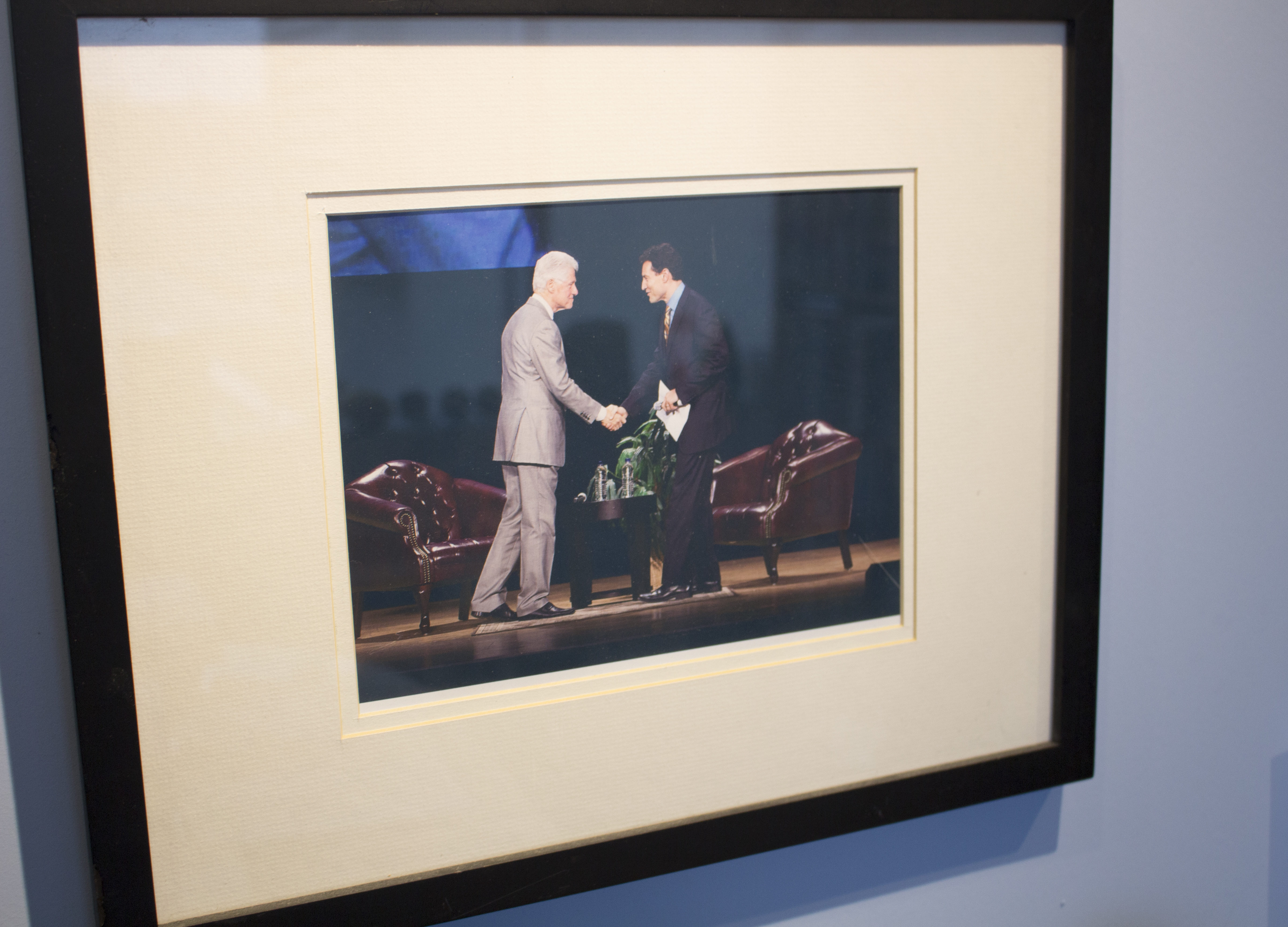

On the wall beside Paikin’s desk hangs a photo from his interview with former president Bill Clinton
-
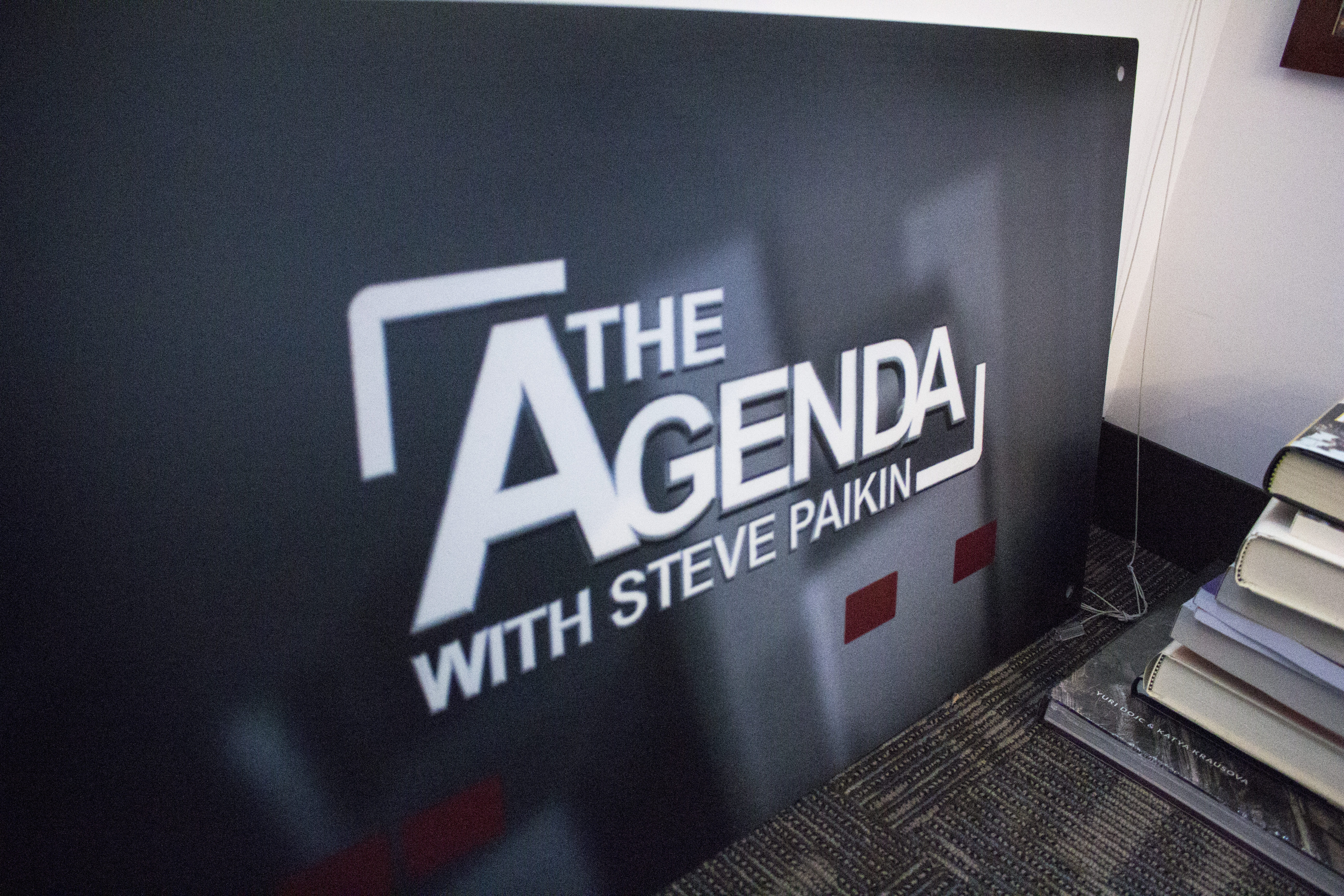

Paikin hasn’t decided where he’ll put The Agenda’s old set sign yet, but he knows he’s going to keep it
-
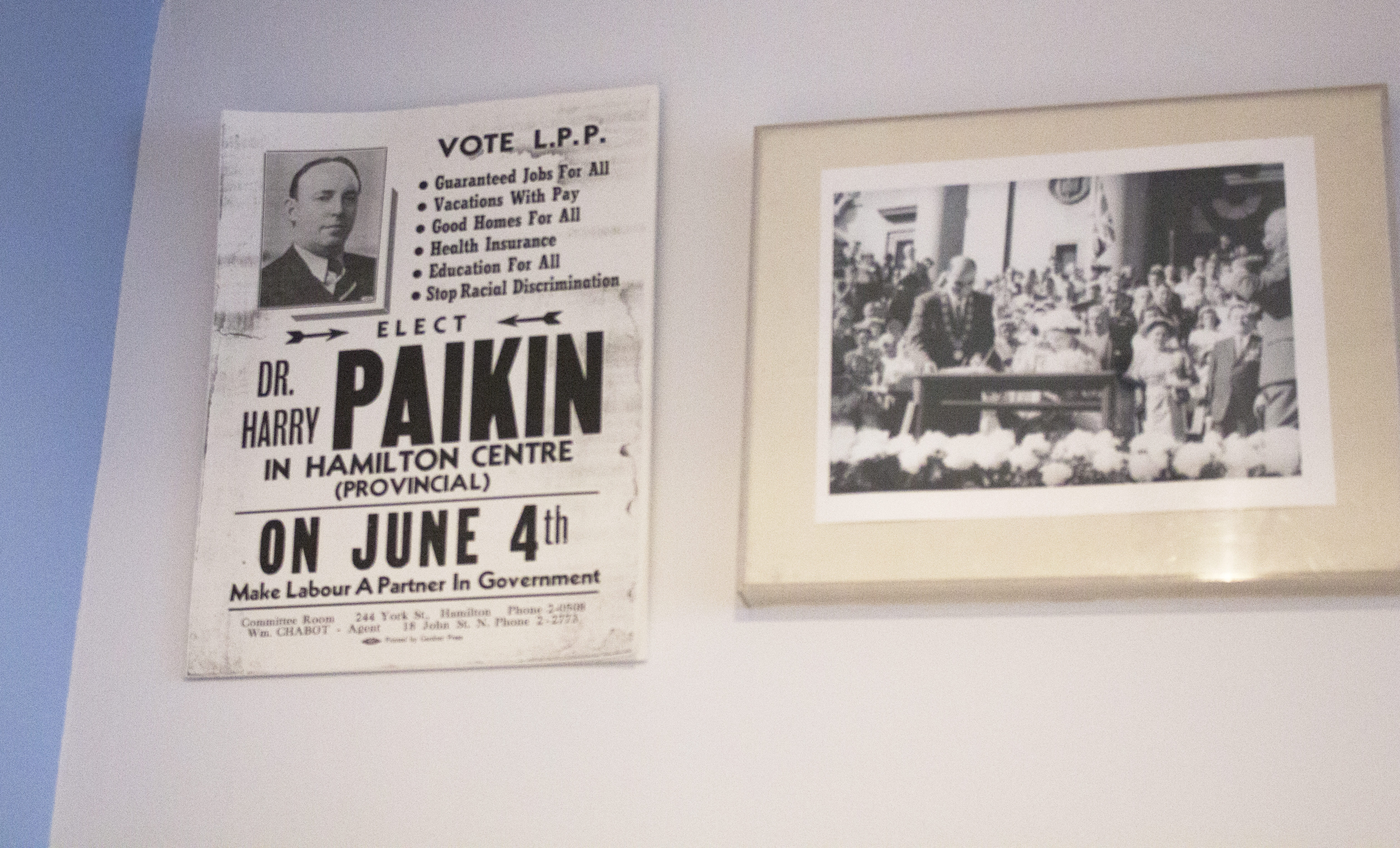

Paikin comes from a politically active family. His cousin, Harry Paikin, was a moral and political force in Hamilton
-
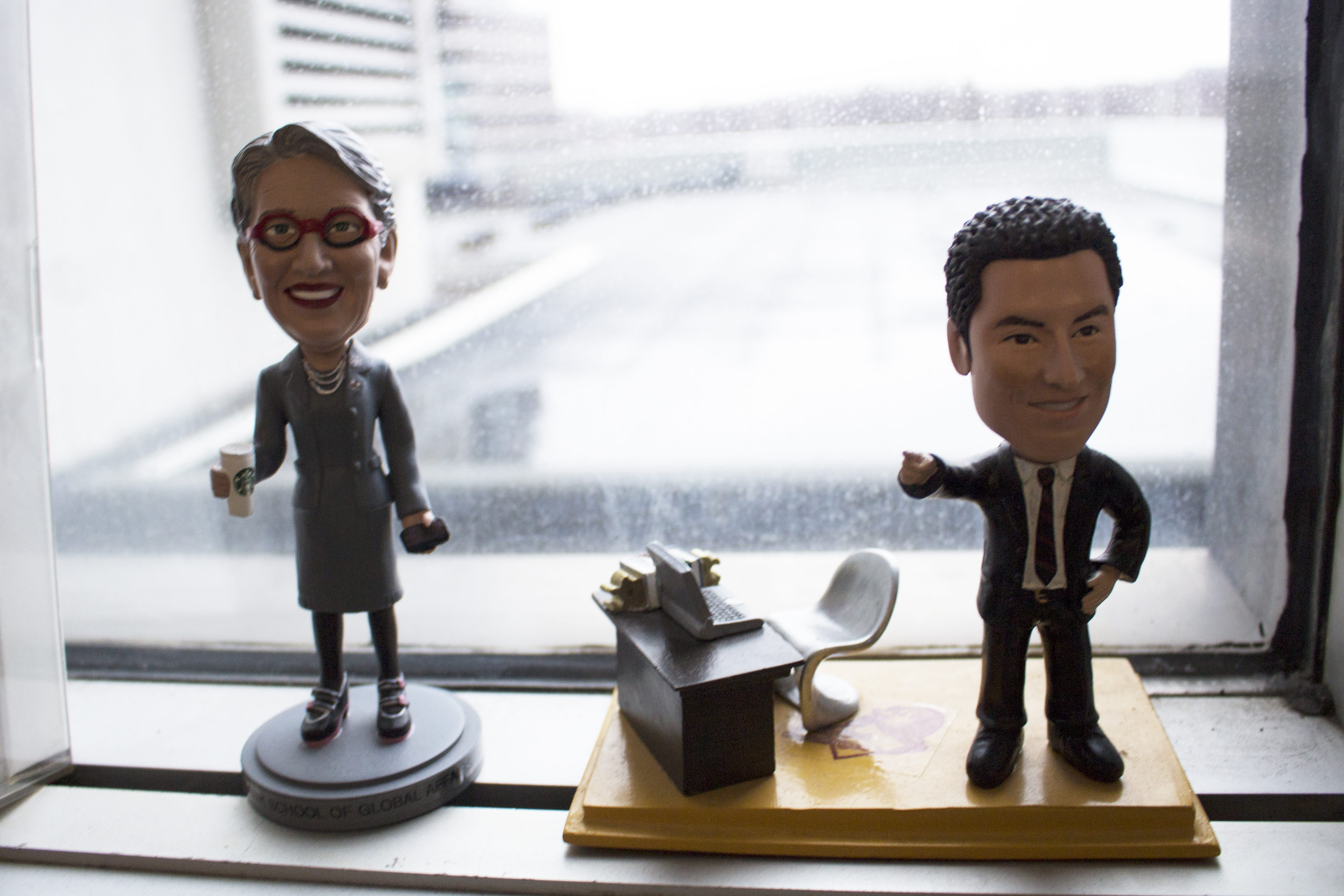

A bobblehead of Janice Stein, political scientist and regular guest on The Agenda, hangs out with a figure of Paikin himself, which he received as a gift
-
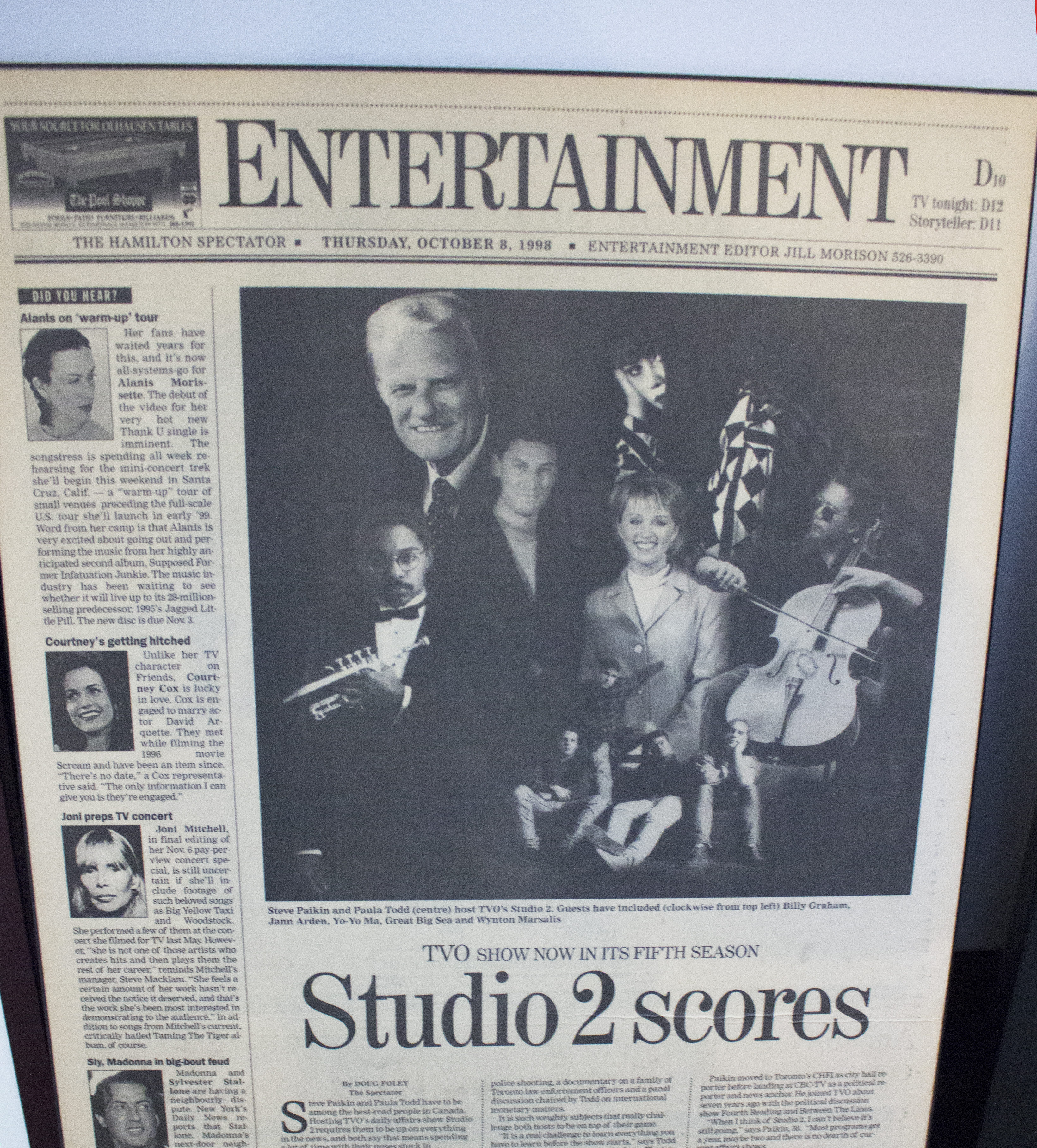

Paikin keeps a few framed newspaper clippings in his office, some featuring him and others written by him
-
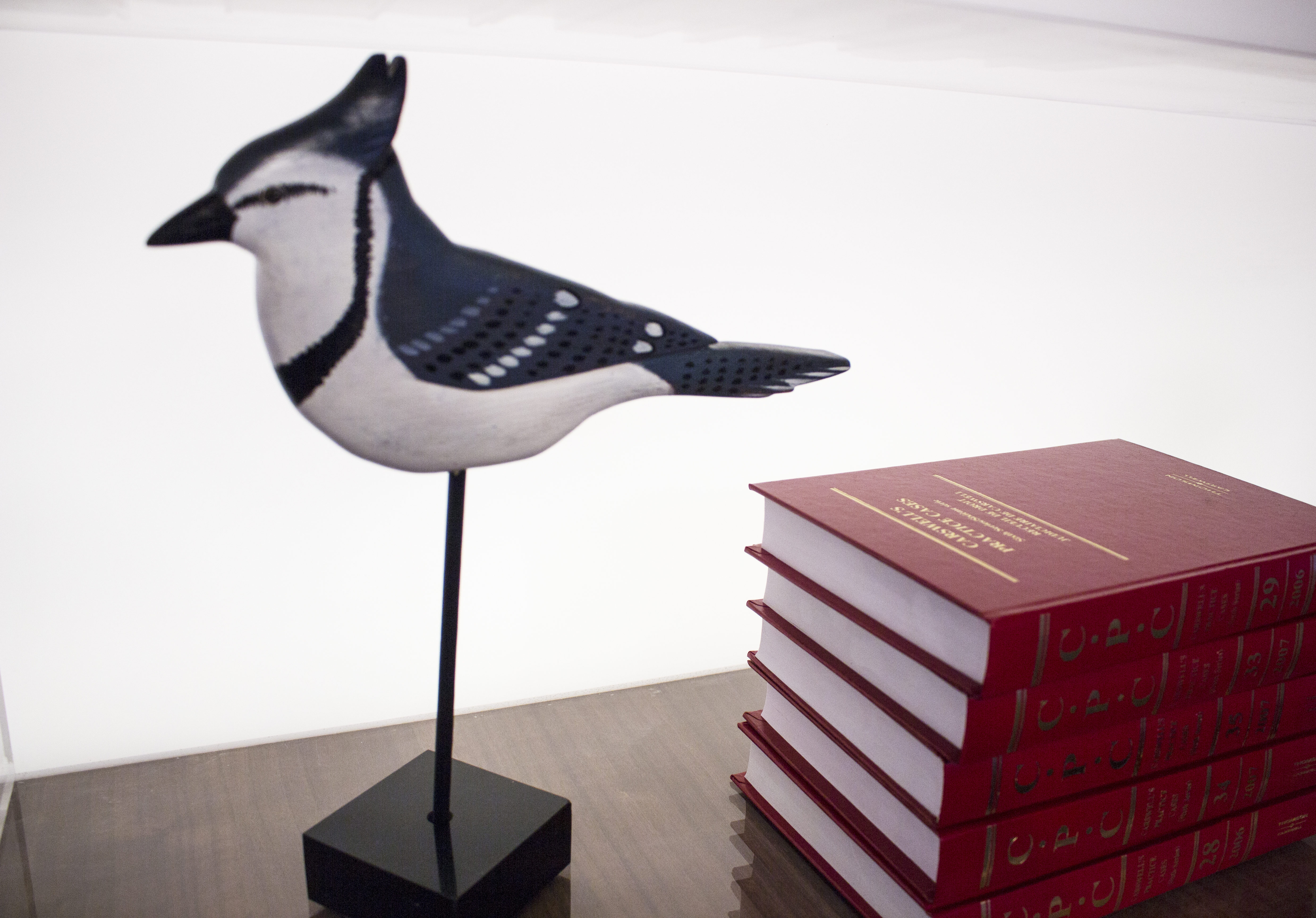

Paikin’s love of baseball comes through in the details of The Agenda’s new set
-
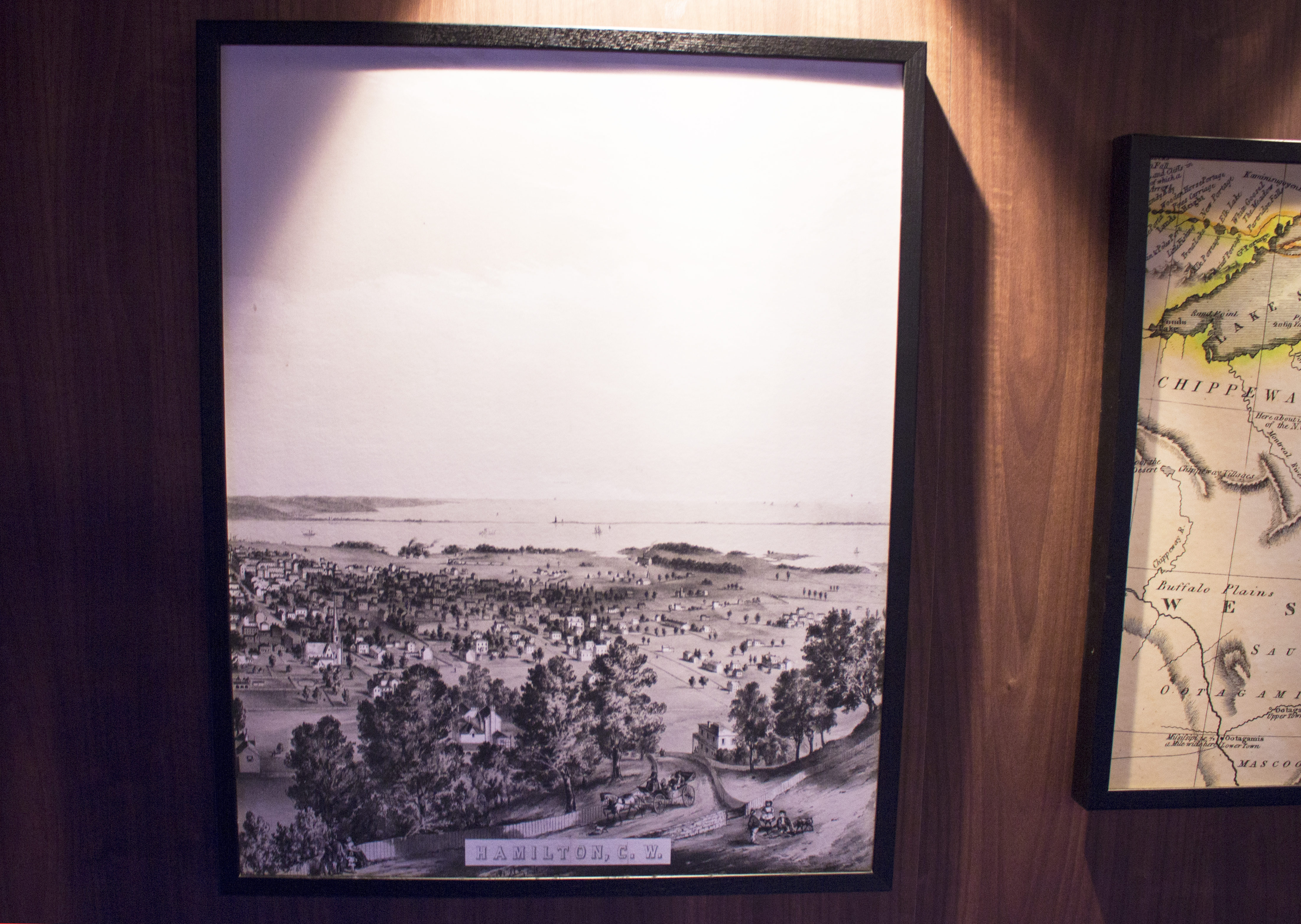

Paikin keeps reminders of his hometown of Hamilton, Ontario around his office and the new set
-
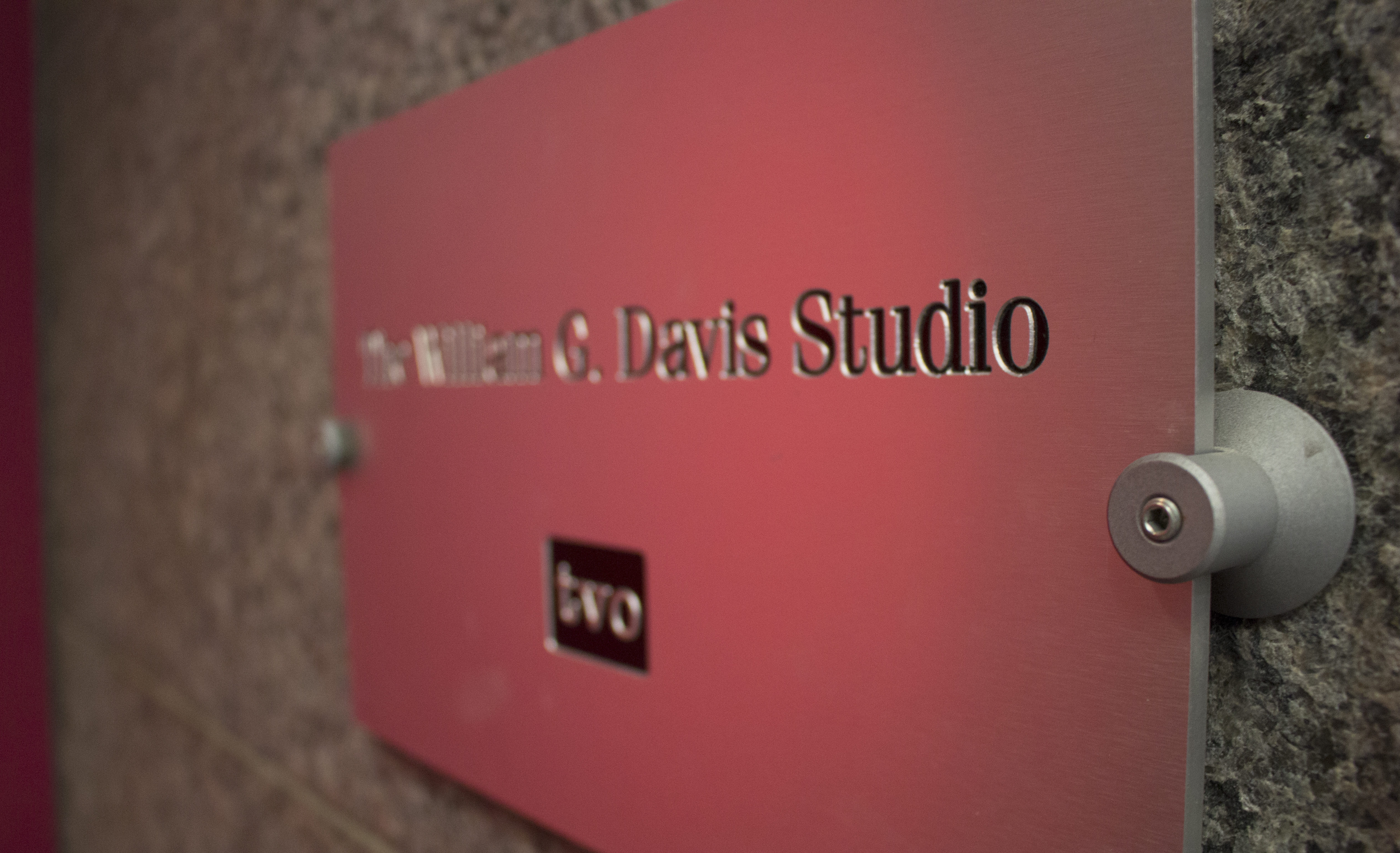

The studio at TVO was named after Ontario’s former premier Bill Davis. In Paikin and the Premiers, he writes that an interview with Davis inspired him to write two books in an effort to understand those who choose to become politicians
Photos by Eternity Martis
“That went well!” a producer says in the control room.
The crew members drop their headphones and step away from the monitors. Onscreen, Paikin bids a friendly goodbye to the guest he’s been interviewing via Skype, a soft-spoken university professor with knowledge of soil quality and treatment. It’s a nuanced discussion about a topic that has the potential to influence how we grow crops and how the rest of the food chain works, but it’s by no means exciting. The professor speaks slowly and quietly. This is not typical television. Some journalists might even call it boring.
Current affairs shows are always at risk of being boring, says Bernstein. It’s incumbent on producers to frame discussions so audiences understand why they’re important. The bigger problem is that shows like The Agenda have lost their ability to tell stories through interviews, says Bernstein. “They’ve become a way to get facts on the air,” he says, “and I don’t think facts are what television is good at.”
John Doyle, television critic at The Globe and Mail, thinks there’s a different reason current affairs programs are boring. “It is difficult to find experts or pundits who are actually good on television,” he says. “And this applies to print journalists. They don’t take it very seriously. They show up and say predictable things, and they say it in a very predictable manner.” Doyle sees a severe lack of energy on Canadian news shows. “For all the craziness you can get on Fox, on CNN, on MSNBC, there is an admirable vigour and liveliness to the discussions that you don’t get on Canadian television.”
Doyle and Bernstein agree a lack of diversity is part of the problem. “I think some of that is sheer laziness on the part of Canadian broadcasters,” Doyle says. He thinks The Agenda is often predictable because none of the guests have anything contrarian to say—part of the trap of working for a public broadcaster: opinions can’t be too far off the mainstream political spectrum.
Bernstein says it’s not just about soft spoken voices, but who the guests are. In an early 2014 blog post titled “Where, Oh Where, Are All The Female Guests?” Paikin wrote about the difficulty he and his producers face booking female guests. When asked to go on the show, women often said they weren’t the best experts on a topic, that they had to stay home with their kids that night or even that their roots were showing.
On Twitter, many people responded angrily, using the hashtag #womenonlyexcusesforpaikin, with lines like, “All of my bras are in the dryer.” Some felt Paikin meant well but criticized him for the language he used and his dismissal of systemic issues that made women respond in those ways.
Others, including Bernstein, feel the post highlighted a larger issue with the show: the producers aren’t trying hard enough to find new female guests, relying instead on a small number of regulars. “If I see Janice Stein one more time, I’m going to throw up. I know what she’s going to say,” Bernstein says of the political scientist and founding director of the Munk School of Global Affairs at the University of Toronto. “Look for someone else. She’s not the only woman in the country who deals with current affairs.”
“I don’t know if the camera’s caught this…what just happened?”
In one of his first interviews on the new set, Paikin speaks to three guests about their efforts to include the history of residential schools in education curricula. One of the guests, Theodore Fontaine, talks about Broken Circle, his memoir of 12 years in a residential school. In a moment the camera didn’t catch, Fontaine clutches something in his hand, and another guest pats his back. Paikin looks away from his list of questions to ask about the gesture.
Fontaine pulls out a green, square pin with a red heart on it. A 12-year-old girl gave it to him when she heard his story. To him, the heart is a symbol of his great-great-great-grandfather, whose name translates to “Two Heart.” He clutches the pin and closes his eyes. “I go to my grandparents and my great-great-grandparents for strength and reassurance that what I’m doing is right.” It’s a slow and quiet moment—likely one that won’t be used in any flashy ads. But it illustrates how The Agenda lets guests talk about difficult subjects, and viewers learn something new with storytelling instead of a list of facts and statistics.
Paikin keeps a list of basic interviewing rules just above his computer, part of his endless quest to get better: no hyperbole; no overloading; you paddle, I steer.
“Every single day of my life, I violate these principles,” he admits. He calls his position at the public broadcaster a “perch” where he can do the in-depth work he loves. TVO has a wholly different mission than other networks—and that’s why he’s been there for 23 years.
Carine is the senior online editor of the spring 2016 issue of the Ryerson Review of Journalism.






